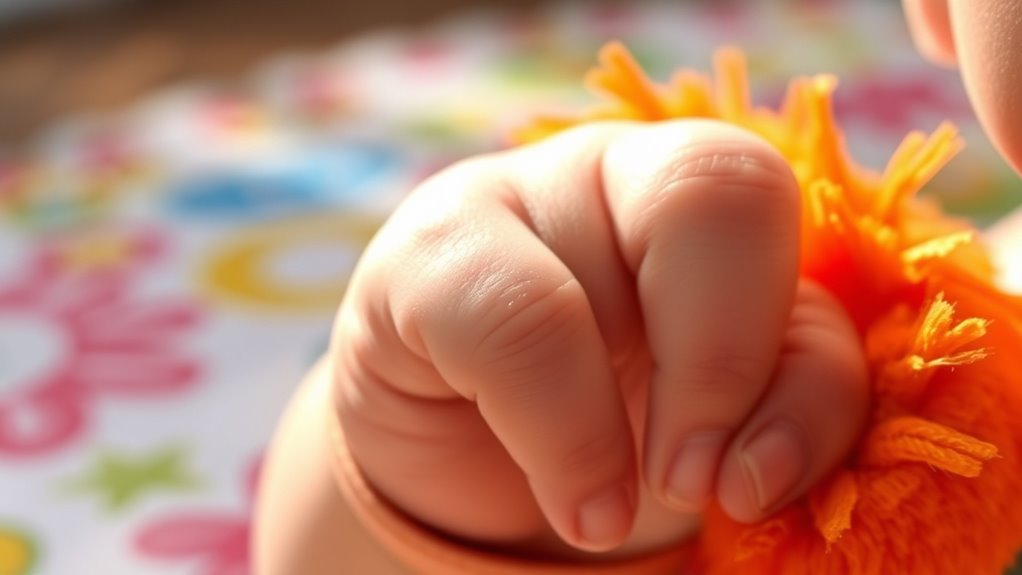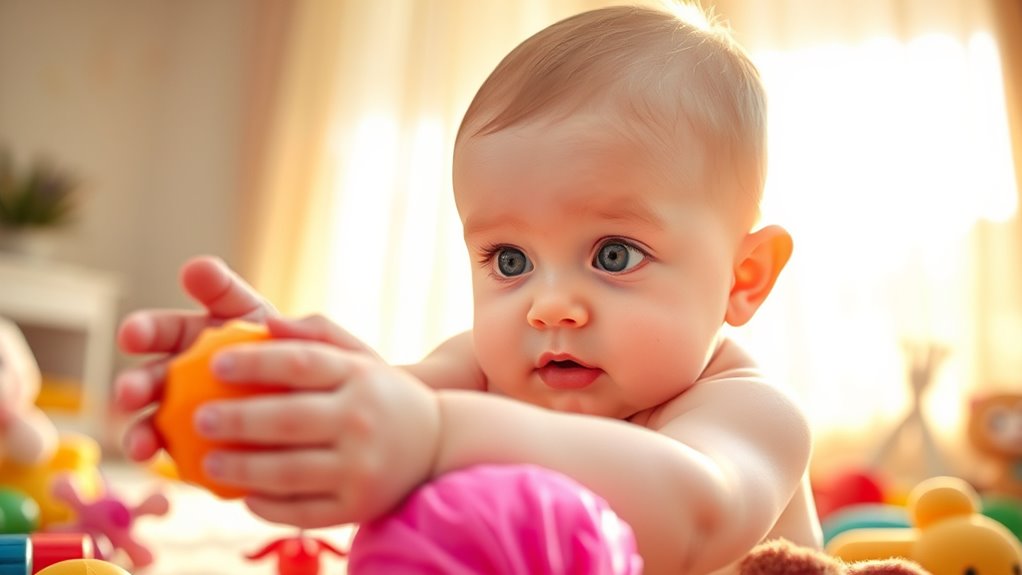Your baby’s grasping skills start developing early through play. At four months, they’ll use an ulnar palmar grasp, and by ten months, they’ll refine it to a pincer grasp. These skills are vital for their cognitive and social growth. Engaging your baby with easy-to-grasp toys and encouraging them to explore different textures supports this development. As they master these techniques, you’ll notice their increased independence in exploration. Keep exploring how play influences their journey!
Key Takeaways
- Engaging in early play with easy-to-grasp toys fosters the development of foundational grasping skills in infants.
- Activities like passing objects between hands enhance coordination and promote muscle strength necessary for grasping.
- Exploring various textures during play helps babies develop their tactile senses and improves their grasping techniques.
- Hand-eye coordination can be improved through playful interactions, supporting the mastery of grasping skills.
- Encouraging social play enhances communication and further enriches the developmental experience related to grasping skills.

As your baby grows, you’ll notice their grasping skills developing rapidly, with significant milestones occurring between 4 and 12 months. Initially, around 4 months, your little one will show the ulnar palmar grasp. They’ll wrap their fingers around objects, excluding the thumb, which is just the beginning of their journey towards mastering hand control.
As your baby grows, watch their grasping skills evolve from the ulnar palmar grasp to mastering hand control by 12 months.
By 5 months, they’ll transition to a full-hand palmar grasp, centering objects in their palms, making it easier for them to explore the world around them. At about 6 months, you’ll see a noticeable shift as your baby starts using the radial palmar grasp. This involves their thumb supporting the object, enabling them to hold onto items more securely.
As they reach 7 months, the raking grasp comes into play. Your baby will use a sweeping motion to pick up objects, showcasing their developing coordination and muscle strength. It’s fascinating to witness how these techniques evolve, enhancing their ability to manipulate objects.
These grasping skills aren’t just about holding things; they play a crucial role in your baby’s cognitive and social development. The ability to reach and grasp early on lays the foundation for further motor skills. As they engage in different grasping techniques, they strengthen their hand and finger muscles, which aids in coordination and dexterity.
You’ll notice how their improved hand-eye coordination allows them to interact with toys more effectively. As your baby continues to grow, they’ll develop more refined grasping methods. By 9 months, the inferior pincer grasp emerges, where they use their thumb and index finger, although with less precision.
By 10 months, this evolves into the pincer grasp, allowing for more accurate handling of small items. By 13-24 months, you’ll see the fingertips in action, using the fingertip pincer grasp and the tripod grasp for even more precise movements, essential for tasks like writing later on.
To support your baby’s grasping development, provide easy-to-grasp toys and encourage activities that enhance hand-eye coordination. Let them pass objects from one hand to another and explore different textures.
These playful interactions not only boost their grasping skills but also foster communication and social interaction, enriching their early experiences. As you engage in these activities, you’re helping lay the groundwork for their future cognitive and motor achievements.
Frequently Asked Questions
What Toys Are Best for Developing Grasping Skills in Infants?
When you’re looking to develop your infant’s grasping skills, consider toys like rattles and flexible plastic balls that encourage holding.
Soft dolls provide varied textures for sensory exploration, while wrist rattles introduce easy-grip surfaces.
Sensory cubes are great for exploration too.
These toys engage your baby’s motor skills and promote hand-eye coordination.
At What Age Do Babies Typically Start Grasping Objects?
By the time your baby reaches about two months old, you’ll notice that instinct kicks in. They start grasping objects placed in their palms, showcasing their innate reflexes.
As they grow, around three months, their movements become more purposeful. They’ll begin batting at toys and exploring their surroundings.
Can Grasping Skills Indicate Developmental Delays in Infants?
Yes, grasping skills can indicate developmental delays in infants.
If you notice your baby isn’t displaying the reflexive grasp or shows inconsistent development, it might signal an issue.
Delays in applying appropriate force or maintaining control while grasping can also be concerning.
Keep an eye on their ability to use both hands around 3-4 months, as delays here can suggest potential developmental challenges that may need addressing.
Early intervention is key.
How Can I Encourage My Baby to Practice Grasping?
Think of grasping as a dance where your baby learns to lead.
To encourage this practice, offer a variety of soft toys, textured objects, and lightweight items that fit comfortably in their tiny hands.
Set up playful challenges by placing toys just out of reach, inviting them to reach out.
Engage in interactive games that involve grasping and releasing, like pulling tissues.
Always supervise to keep their exploration safe and fun!
Are There Any Safety Concerns With Toys for Grasping Practice?
Yes, there are safety concerns with toys for grasping practice.
You should avoid toys with small parts, as they can pose choking hazards. Check for sharp edges and ensure toys are made from non-toxic materials.
Always supervise your baby during playtime and store toys safely to prevent accidents.
Look for toys that meet safety standards and avoid those with strings longer than 7 inches to reduce entanglement risks.
Safety is key!
Conclusion
As you watch your little one fumble with toys, it’s easy to think they’re just playing. Ironically, they’re not just having fun; they’re mastering crucial grasping skills that lay the foundation for future learning. Each clumsy grab and shaky reach is a step toward independence, proving that even in the chaos of babyhood, profound development is happening. So, the next time you see that tiny hand struggling to hold a block, remember: it’s all part of the big plan.









